THE U.S. NAVY MODEL 1861 AND
U.S. ARMY MODEL 1862
PERCUSSION SIGNAL PISTOLS
~ by Dave Radcliffe armscollectors.com ~
Both pistols used Coston's cylindrical single and multi-color "lights" for signaling at night in the same manner as signaling flags were used during the day. They were used over land or water. Under good conditions the Coston light system had a practical working range of 5 miles or so. The Coston flares were not projected from the muzzles of these pistols but were rather held in the barrel by closing the locking lever which clamped the flare in place. A standard percussion cap was placed on the nipple, the pistol was cocked, held away from the body, pointed upward and the trigger pulled. The exploding cap ignited the signal light at the front end furthest from the muzzle and the holder of the pistol held it upright from 8 to 26 seconds, depending on the type of flare, until the light burned out. It was then ejected by moving the barrel lever forward allowing a new signal light to be loaded. A one light Coston signal burned for about 8 seconds. The two light signal lasted around 17 seconds and the three light about 26 seconds.
Coston light signals came in white, red, green and blue configurations. Red was 0, green was 1, green/red was 2, white/white was 3, green/white was 4, red/white/green was 5, white/red/white was 6, white/green was 7, red/white/red was 8 and red/white was 9. The letter "P" (prepare for signal) was white, "A" (affirm) for answering or ready to receive was white/red/green. "Int" (interrogatory) for questioning was white/green/white, "N" for numbers following was green/red, "B" which requested information, was blue/blue and "Geo", meaning not understood, was green/white/green.
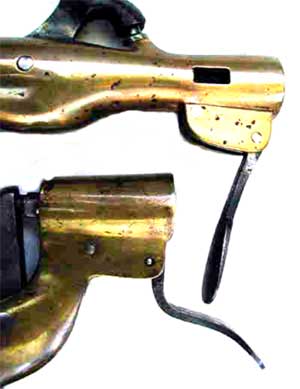
The combination locking and ejecting levers
in their forward position.
| |
|
|
|
In the two and three element signal lights, the 8 second pyrotechnic elements were separated by an ignited/delay element which made each color burn separately from the one before it. Each of the waterproof units had color bands on the body indicating the colors it would display.
The U.S. Navy Model 1861 Percussion Signal Pistol was manufactured at the U. S. Navy Yard, Washington, D.C. in a total quantity estimated at 1,000. With the exception of a steel combination locking and ejection lever, steel trigger and screws, it is of all brass construction. It is 9-5/8" overall with an inside muzzle diameter of .75. The muzzle is ported and there is a flat tapered metal tongue-like protrusion therein about ¾" long that appears to have been used to hold the Coston light signal flare (the 1862 Army model does not have this metal protrusion). There is a removable plate on the left side of the pistol and a trigger screw. Those features make it easily distinguishable from the similar looking U.S. Army Model of 1861 which is seamed in the center and does not have the removable side plate or a trigger screw.
The markings on the left side of this pistol are: "U.S.O.Y.W." (United States Ordnance Yard Washington) over "W. M." (William Marston?) over "1863". The serial number "17" is stamped on the frame in front of the removable side plate and on the side plate itself at the front opposite the frame marking.
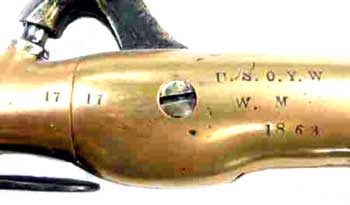
Stampings - Left Side of Pistol
| |
|
|
|

Bottom View

Top View
| |
|
|
|
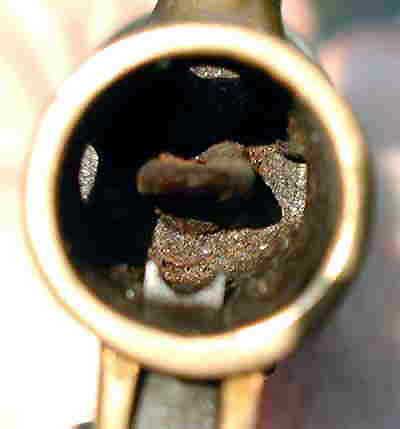
Business End Of Pistol
(Note Metal Tongue-like Protrusion at Muzzle Base)
| |
|
|
|
The U.S. Army Model 1862 Percussion Signal Pistol was manufactured by William Marston at New York in 1862 in an estimated quantity of 1,000. It has an all brass frame with steel hammer, trigger and combination locking and ejection lever plus two-piece walnut grips. It is 7-5/8" from the bottom end of the grips to muzzle center. The inside muzzle diameter is .75, the same as the navy model. However, the short, stubby, flared 1¾" "barrel" is not ported and there is no internal protruding tongue. Whether it took a different type of Colson "cartridge" is unknown to me. There is also a removable plate on the left side of the pistol but no trigger screw.
This pistol is stamped on the frame at the bottom center of the grips with 5 separate stampings. They are "ARMY SIGNAL" - "PISTOL" - "1862" - "A.J.M." (Inspector) and "1862". The serial number "1031" is stamped upside down on the lower left side of the frame. The grips cover this stamping. There is also an "I", "1", or lower case "L" stamped to the side of the serial number (see picture below). Both wood grip pieces are stamped, on the inside top, with the same number "1031".

Top View |

Bottom View
| |
|
|
|
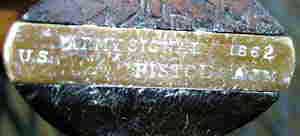
Butt Frame Stampings
| |
|
|
|
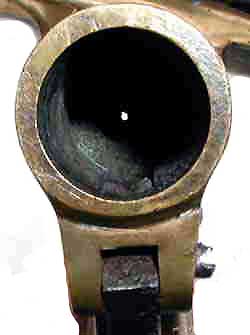
Business End of Pistol
| |
|
|
|
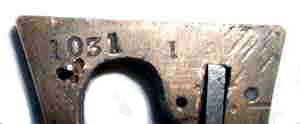
Serial Number
Lower Left Frame Under Grip.
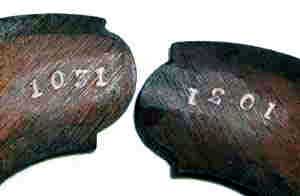
Serial Number Stampings
At Top Inside Grips.
| |
|
|
|
While they served, they were the best we had. Both are highly desirable collector items.
References used for this postings were "FLAYDERMAN'S GUIDE TO ANTIQUE AMERICAN FIREARMS.....and their values" by Norm Flayderman. "SMALL ARMS OF THE SEA SERVICES" by Colonel Robert H. Rankin, USMC (RET) and most of all, an article entitled "A COSTON SIGNAL LIGHT DISPLAY BOARD" by Konrad F. Schreier given to me by Fred Ellis, the honoree of this posting. The bibliography for that article was given as: "FARROW' S MILITARY ENCYCLOPEDIA", Military-Navy Publishing Co., New York, 1895. Lustyik, Andrew F., "MILITARY PYROTECHNICS", Gun Report, Aledo, April, May and June 1968 issues and Russel, Frank, "EARLY U.S. MARTIAL SIGNAL PISTOLS", Gun Report, Aledo, August 1970 issue, plus unspecified miscellany.
